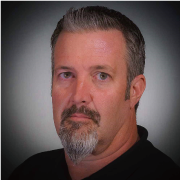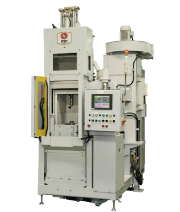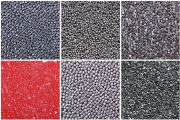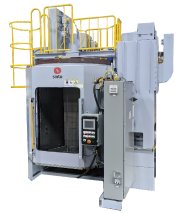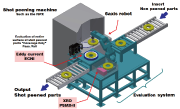Sinto America’s Surface Treatment (SST) division now offers a wide range of peening and blast cleaning equipment, vibratory finishing equipment, consumables and technologies that provide solutions to their customer’s toughest challenges. Charlie Gorman (VP SST) and Wesley Edwards (Peening Line Manager) discuss various products and services that Sinto brings to the surface finishing industry.
(?) MFN: I thought that Sinto was only in the foundry industry, but based on your website, it looks like you are in many more areas?
(!) C. G.: Worldwide, Sinto is well known for surface treatment applications; currently, in the United States, Sinto is working on growing our presence in the surface treatment industry. Through offering innovative equipment, along with surface technology services and blasting abrasives, we are expanding our presence in North America.
(?) MFN: Why would a customer choose Sinto over the more well-known finishing equipment brands?
(!) C. G.: Sinto is the only equipment manufacturer offering machines, abrasives, parts and service. We consider which abrasive will provide the best results and design the equipment in concert with the abrasive recommended. This can reduce cycle times by as much as 50% versus competitor’s equipment and save not only in long-term running costs but often on the cost of the capital equipment as well.
(?) MFN: What makes Sinto unique with regards to blast equipment?
(!) C. G.: It starts with the blast wheels. The Sinto Y-30 wheel is a tool steel, 14” diameter, bi-directional, belt-driven or direct-drive wheel that delivers very high abrasive flow rates and very high abrasive tip velocities. In field trials, we have seen it clean as fast as or faster than the latest design of 16” diameter wheels with wider blades. The Y-30 is a two-sided, dual-runner head design that keeps the abrasive on the blade, which also reduces maintenance costs with less liner and component wear when compared to competitive wheels.
Our WE-3 air wash separator is simply the best in the industry. We use a 12” abrasive drop, which increases abrasive dwell time in the cleaning area. The WE-3 air velocities range from 1,800 fmp to 2,800 fpm compared to traditional airwash separators using air velocities of 300 fpm to 450 fpm. This higher velocity airflow cleans the abrasive much better than standard air wash systems and even surpasses the cleaning you would get from magnetic separation, which is an expensive mechanical device that also requires maintenance. The WE-3 cleans up to 99.7% of all moulding and core sand out of the abrasive operating mix on the first pass. The WE-3 will not lose efficiency if the abrasive hopper level gets low and can be retrofitted onto any blast machine. This is truly ground-breaking technology.
(?) MFN: It sounds like Sinto has some pretty cutting-edge technology to present to the North American market. Is there any other new technology that Sinto is introducing?
(!) C. G.: Sinto has technology for non-destructive testing to measure compressive residual stress achieved in a peening process that is fast enough to use in-line. So, 100% quality check is now possible for production parts. We also have a patented service technology, D-SCC, to mitigate stress corrosion cracking within the water cooling holes of dies used in the die-casting industry, which so many struggle with today. We can discuss this later in the interview with Wesley Edwards, Peening Line Manager, at Sinto.
Frohn North America is now introducing Duramax Oxgrit abrasive. Oxgrit is atomized, then crushed to achieve an angular shape. This is good for any type of surface preparation and coating removal. Since it is manufactured from steel slag, it has many of the characteristics of cast steel abrasive but at a price point closer to that of garnet. Oxgrit will cut faster than alluvial or hard rock garnet, and generates little or no dust during the process. The low dusting is also due to Oxgrit’s low breakdown rate so Oxgrit, unlike many mineral abrasives, can be recycled and used multiple times.
(?) MFN: Wesley, you’ve been in this business for a long time, what do you like most about Sinto?
(!) W. E.: The first thing I noticed after coming to work at Sinto was that it felt like a family and that everyone was there to help. You do not find that very often with companies this size.
(?) MFN: That is always a benefit of companies you work for. Is there anything specific you are working on right now?
(!) W. E.: Right now, we are heading into a very busy trade show stretch so there is a lot of work being put in behind the scenes on these, especially because it has been so long since our last show due to Covid. The first one that we had this fall was the Motion + Power Technology Expo in St. Louis, where we displayed our Sightia Surface Evaluation product line. Sightia is a non-destructive in-line quality inspection system. At the show, we were able to have several micro gears on display that have gone through shot peening or mass finishing or both, and we were able to share the actual residual stress, as well as the hardness, after each step of the process. All of this data can be collected in-line on the product floor by using the equipment found in our Sightia product line.
(?) MFN: You mentioned shot peening and mass finishing were used on the micro gears. Is Sinto capable of doing both of these processes?
(!) W. E.: Good question, because I do not think that everyone realizes that Sinto does manufacture both shot-peening equipment and mass-finishing equipment. Additionally, we also manufacture our own cut-wire products for use in shot-peening and general shot blasting applications and our own line of mass finishing media; including, ceramic, plastic and specialty media such as our dry-finishing media.
(?) MFN: Wow, I didn’t realize that Sinto got into all of that. So, what makes Sinto’s machines and consumables different than all the others in the market?
(!) W. E.: For our peening equipment, we specialize in the one-piece flow style machines. Depending on the part configuration, you may actually be peening a couple of parts at a time, but generally speaking, you aren’t running a large batch of parts at one time. Of course, we also have our batch style machines but there are a lot of competitors out there making the same types of machines, almost saturating that market. Then, you couple our peening machines together with our Sightia inspection equipment and our cut wire for shot peening, and you have a complete package to offer, instead of just a piece of the puzzle.
(?) MFN: What about the mass-finishing product line you mentioned.
(!) W. E.: Similar to what we have done with our shot-peening equipment, our mass-finishing equipment is targeted for specific applications. Take for example, our high energy centrifugal disk machine. We manufacture a dry version of this machine that is extremely valuable to those who manufacture parts where rusting might be a concern. Our dry-finishing media, which is used for all dry processes, is like no other media that I have seen before. Compared to your typical wet type ceramic or plastic media where you may have water and compound running constantly to keep the parts and media clean that then also generates a waste stream to be dealt with, our dry-finishing media outperforms a wet process for most applications and then you can additionally reduce your total operating cost by eliminating the water and compound. The media cuts and wears just like any other, but does not need the water or compound to keep it performing as desired.
(?) MFN: So, is this the “magic” media that everyone dreams about that cuts fast and wears slow?
(!) W. E.: Ha-ha, not quite but it is getting close!
(?) MFN: Was this the media that you used on the micro gears?
(!) W. E.: No, the media that we used on the micro gears is something new that we are working on with additive manufacturing in mind. By using the same process on the gears, it gave us some additional information about what is going on during the process and the effect that the process has on the surface of the part.
(?) MFN: What did you find out by running the process on the gears?
(!) W. E.: I cannot go into great detail yet, as this is something new to the market but I will say that we saw a positive change in the compressive stress layer and a great improvement in the surface finish, which tells us that we are on the right path.
(?) MFN: That is exciting! When do you expect a release on this new process?
(!) W. E.: We still have lots of testing to complete and have already captured the interest of some key players so they are pushing us too, but it is not something we are going to rush getting to market too quickly, without knowing all of the potential.
(?) MFN: Does Sinto offer any other surface treatment machines or processes?
(!) W. E.: Yes, Sinto has three D-processes that are targeted towards the die casting industry. The D-Flow is a process that improves the flow of melted aluminum by creating dimples on the surface of the mould, reducing defects. D-Check, also offered by our sister company National Peening, is another peening treatment for the mould surface. Both of these technologies, DSCC, which is a patented Sinto process, peens the inside of die water cooling holes to help extend the life of the die. It is not uncommon to extend the die life by up to 200%, and some customers have experienced 300% increase in die life.
Sinto also offers a non-destructive testing product line for production use known as Sightia. This is a two-part system that can be integrated into new peening machines or into existing peening machines or operations.
The two parts that make up Sightia are the PSMX-II and the ECNI. The PSMX-II measures residual stress and the ECNI evaluates the surface of a part. Both products can be used in tandem or on their own. The PSMX-II performs a residual stress analysis of a part in ten seconds and the ECNI device performs a complete surface evaluation in two seconds or less. When used together, these devices can perform 100% part quality check within the production line.
(?) MFN: Thank you for answering all of our questions! We look forward to seeing how Sinto can grow in the finishing world.
(!) W. E.: No problem. We appreciate you taking the time to chat with us and discuss a few of our products and services that will help us move forward in the surface finishing market.
MFN would like to thank Charlie Gorman and Wesley Edwards for this interview!
For Information:
ROBERTS SINTO CORPORATION
A SINTO AMERICA, INC. COMPANY
150 Orchard Street
Grand Ledge, MI 48837, USA
Tel. +1.517-371-2460
Fax +1.517-371-4930
E-mail: Kendra.Harmon@sintoamerica.com
Charlie.Gorman@sintoamerica.com
Wesley.Edwards@sintoamerica.com
www.SintoAmerica.com

